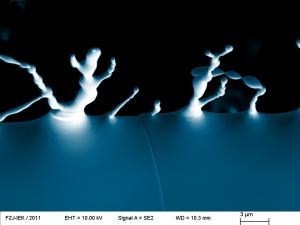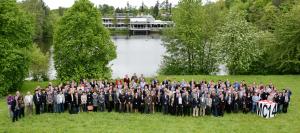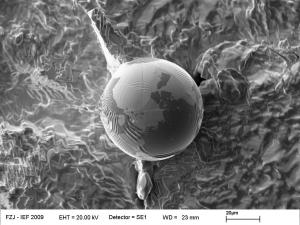Plasma-facing components for ITER and beyond
28 May 2013
-
Jochen Linke, Forschungszentrum Juelich
Re-solidified tungsten melt after high heat-flux exposures in the TEXTOR edge-plasma (power density: 20 MW/m2, exposure time: 5 s)
During the 14th International Conference on Plasma Facing Materials and Components (PFMC-14, 13-17 May) in Jülich, Germany, the focus was directed towards solving the issues related to wall materials and components in a future fusion reactor. Basic material and physics issues were linked with engineering activities related to fusion materials, producing synergistic results for future research.
Prior to the main conference, a tutorial course was given by experts; these introductory lectures were dedicated to PhD students, postdocs and newcomers in the field. Surprisingly, roughly three-fourths of all participants used the chance to update their knowledge and get an inside view into other research areas by attending these tutorial lectures.
More than 200 international scientists from 28 nations attended the conference in Jülich to discuss the viability of existing and future material options—in particular the plasma-facing materials for the first wall (beryllium) and the divertor (tungsten, carbon) in ITER, but also future material options including tungsten alloys, steels and even liquid metals. Results obtained to-date related to materials and components under extreme conditions are influencing upcoming decisions on ITER operation.
One important decision to be made is the selection between carbon and tungsten as material for the strike point area of the first ITER divertor—a decision scheduled for later this year. Furthermore, solving issues related to the highly demanding operational requirements of a future power plant such as the combination of steady state operation, high neutron loading, material erosion and component lifetime under the high particle and heat fluxes, is the next step to affordable and safe fusion power.
Tungsten droplet originating from ELM-simulation experiments in the electron beam test facility JUDITH 1.
As a special highlight at this year's PFMC conference, the first results of the ITER-like wall at JET were discussed in a special session. Operating since 2011 with a beryllium main wall and an all-tungsten divertor, JET is a direct test bed for a better understanding of the plasma operation within the environment of the ITER-specific plasma-facing materials mix. It becomes even more relevant as carbon may be completely ruled out for use in ITER from the first day of operation. Results related to beryllium material migration, fuel retention, and material morphology are now available from JET and investigations are ongoing to transfer the obtained data directly to ITER.
The PFMC-14 Young Scientists Poster Prize was awarded to Rianne 't Hoen (FOM Institute DIFFER—Dutch Institute for Fundamental Energy Research, Association EURATOM-FOM, the Netherlands) for her contributions to the "High Flux and Fluence Exposures of Pre-Irradiated Tungsten to Deuterium Plasmas."
The next PFMC-15 conference will be held in Aix-en-Provence, France from 18-22 May 2015.




